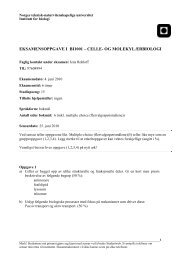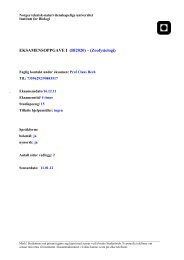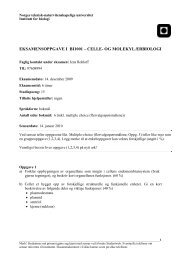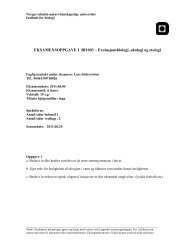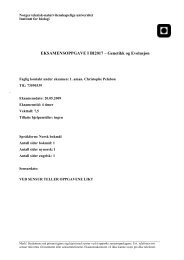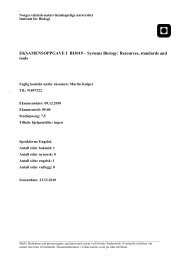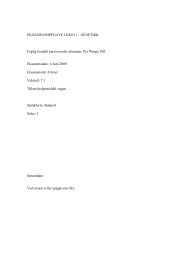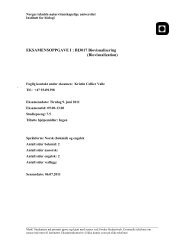eksamensoppgave i bi2033 â populasjonsøkologi - Institutt for biologi
eksamensoppgave i bi2033 â populasjonsøkologi - Institutt for biologi
eksamensoppgave i bi2033 â populasjonsøkologi - Institutt for biologi
You also want an ePaper? Increase the reach of your titles
YUMPU automatically turns print PDFs into web optimized ePapers that Google loves.
Engelsk:<br />
Question 1<br />
a) In a small insular population of a passerine bird species Passer umulius where all<br />
individuals die during their third year of living there is counted 100 0-age individuals in<br />
the end of the breeding season. In the end of the breeding season two years later there are<br />
225 0-age individuals, and 25 two years old individuals present. What is the stable<br />
agedistribution in this population when we assume that survival rate is independent of<br />
age<br />
b) In another insular population of the same species one counts 16 individuals in two<br />
consecutive years and one assumes that the population can be regarded as stable. How<br />
large must the average clutch size be in this population if we assume that the age of<br />
maturation is 1 year, the sex-ratio is 1:1, no age-dependent reproduction and the same<br />
survival as in the larger population<br />
c) In which of these two populations will the 0-age individuals have the larger contribution<br />
to future population growth<br />
d) Describe how the two main types of stochasticity that affects population growth in natural<br />
populations will affect these two island populations differently.<br />
e) The population in a) is monitored further and after 2 new years they count 250 0-age<br />
individuals and 56 two years old individuals. All the assumptions in a) and b) are not<br />
necessarily valid. Can you identify limiting and regulatory factors (mortality and<br />
reproduction) in this population<br />
f) The individuals of these two island populations belong to the same species, but on a third<br />
island they appear together. It appears that descendants of the colonizers from the two<br />
islands differ more morphologically compared to what the colonizers did in the first place.<br />
Describe two explanatory models <strong>for</strong> such divergence in morphology.<br />
Question 2<br />
a) What do we mean by ”functional respons” Illustrate in a figure the 3 types that you<br />
know, and explain the ecological mechanisms that generate each of the different patterns.<br />
b) Explain (and illustrate with figures!) the different main types of harvesting-strategies.<br />
Discuss advantages and disadvantages of these harvesting-strategies.<br />
Question 3<br />
Levins introduced the classic model of metapopulastion dynamics in 1969.<br />
a) Describe Levins’ model and the different parameters that are included in the model.<br />
b) What is required <strong>for</strong> a metapopulation to be viable or persistent (i.e. not going extinct)<br />
c) What do you understand with the term ”rescue effect”<br />
d) What do you understand with the term ”source-sink dynamics”<br />
Side 6 av 7<br />
Eksamensoppgaver 2010.doc





